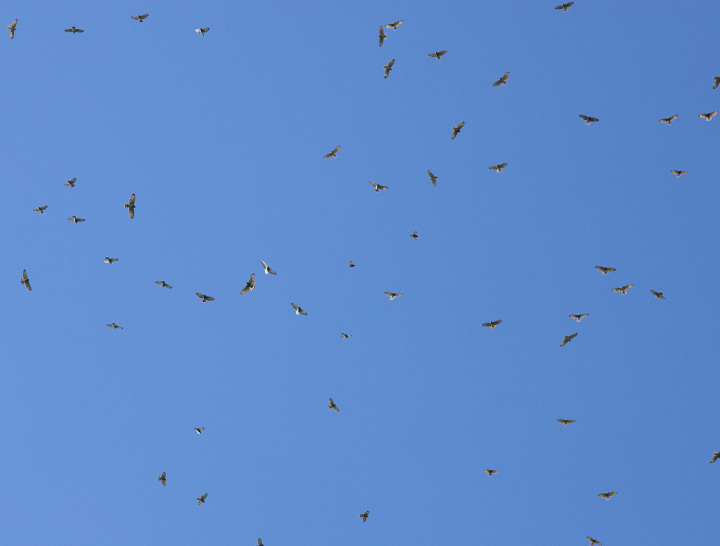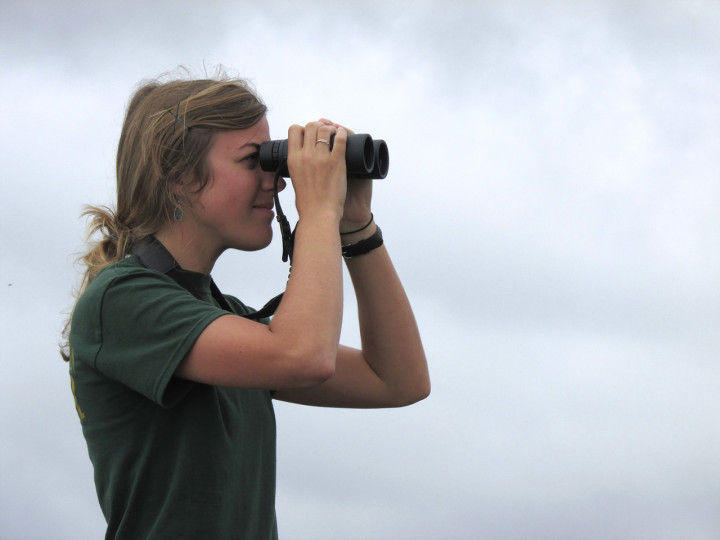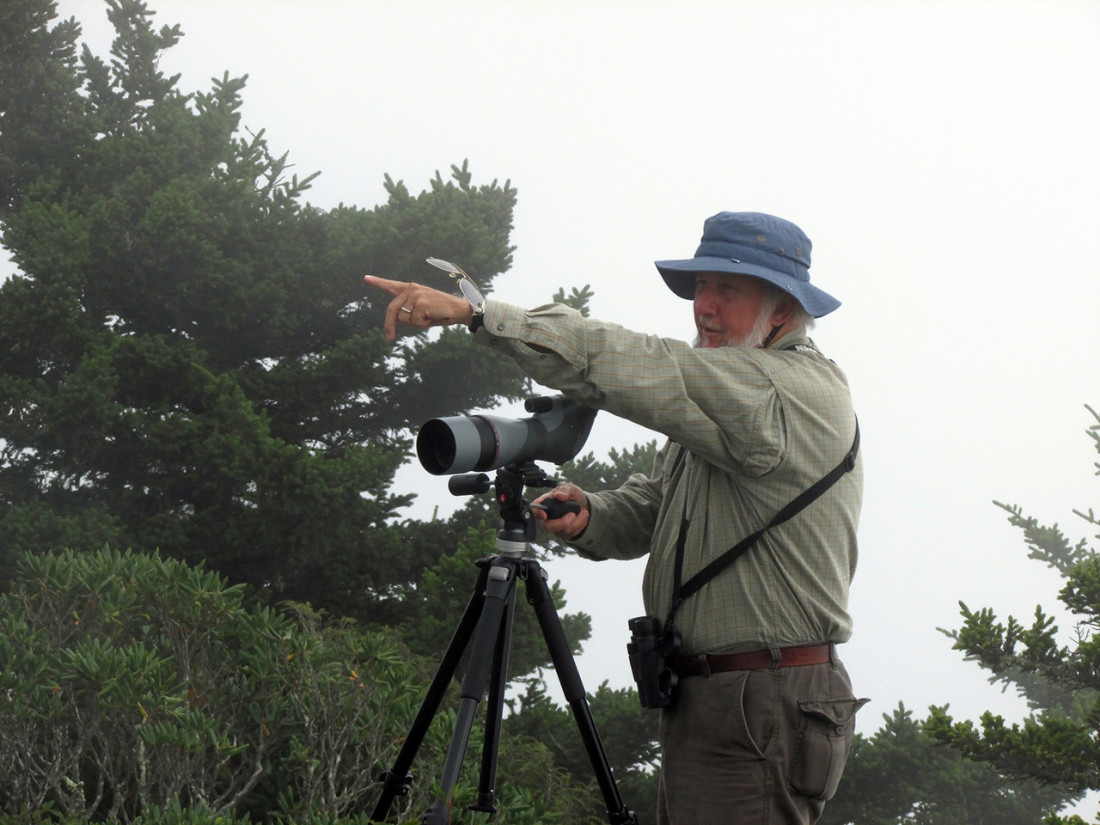For most people, a single raptor soaring overhead is enough to draw stares, hushed gasps and pointing fingers. Birds of prey such as hawks and eagles are impressive enough in the regal, solitary flight that makes them symbols of power around the globe. But Lauren Lampley, naturalist with the Grandfather Mountain Stewardship Foundation, is disappointed if she doesn’t see a couple hundred of them daily.
Her goal isn’t unrealistic, at least during this time of year. Throughout early fall, millions of raptors from the U.S. and Canada are on the wing to overwintering sites in Mexico and South America. Grandfather Mountain lies directly on the Central Appalachian raptor migration corridor, and regional bird watchers converge on the park’s Linville Peak each day in September to take in the spectacle.
Since 2008, the Grandfather Mountain Hawk Watch has recorded data on the number and species of migrating raptors that pass through the area. Official counters such as Lampley work with more than 40 volunteer spotters to tally as many birds as possible. “We’ve seen over 9,000 hawks come by in one day, bald eagles fly about 200 feet above our heads, peregrine falcons and ospreys,” says Lampley.
Amy Renfranz, director of education and natural resources at Grandfather Mountain, explains that the site is uniquely suited for a raptor census. “It’s the same reason Grandfather Mountain was once a hot spot for hang gliding: all the exposed rocky outcrops,” Renfranz says. “Air warms up along those rocky places and starts to rise, creating strong upward winds that attract these large birds.” The relatively treeless ridgetop also provides unbroken views in all directions on clear days.
ID check
Although the mountain may boast ideal conditions, correctly picking out different raptors can still be difficult. Lampley, who is entering her third season as an official counter, puts the challenge like this: “Take American kestrels, which are about the size of a blue jay, and ospreys, which are about three times that size. At two miles away through a spotting scope, they both look like tiny little specks,” she says.
Counters must instead rely on other clues to determine a raptor’s true identity, such as silhouette and flight behavior. Even from far away, skilled birders can distinguish American kestrels by their sharply pointed wings and direct, speedy flight; Lampley calls them “the fighter jets of the bird world.” In contrast, ospreys have gull-like wings designed for takeoff from water and sometimes hover before diving from their flight to catch fish.
The most striking behavior belongs to the broad-winged hawk. This unusually gregarious raptor migrates in huge groups known as kettles (a long-used birding term that finally entered the American Heritage Dictionary this year). Groups of hundreds or thousands spiral together around thermals to gain altitude, resembling a cauldron of birds brought to a rolling boil.
Kettling makes broad-winged hawks easy to identify, but actually counting their massive numbers requires special approaches. Lampley usually performs a full count for one field of view through her spotting scope, then multiplies that amount by the number of fields needed to cover a rotating kettle. If the birds are coasting from one thermal to another, she’ll instead lock her scope on a single point of sky and wait for them to move across. “We have a clicker and count them individually as they glide by — it’s almost like a highway of hawks,” Lampley says.
Flocking together
Grandfather Mountain contributes all of these observations to HawkCount, an online database of over 300 watch sites managed by the Hawk Migration Association of North America. Stretching from Eureka, Alaska, in the northwest to Panama City, Panama, in the southeast, this network of raptor enthusiasts helps scientists learn more about the health of bird populations across the continent.

“A lot of raptor species are elusive and hard to track with breeding bird surveys or winter counts. That’s why migration data are so important,” says Julie Brown, monitoring site coordinator for HMANA. “All the sites together paint a picture of how species are doing in different regions and how migration routes are changing.” With this information, conservationists can make better decisions about what areas and birds are most crucial to protect.
The past decade of HawkCount data gives a mixed status report for raptor species. Although bald eagles, merlins and peregrine falcons have increased in number, sharp-shinned hawks, ospreys and Cooper’s hawks have declined. The American kestrel has also suffered major losses, primarily due to human development of its grassland habitat.
Renfranz adds that raptor counts have scientific importance beyond the birds alone. “Based on the presence of these top predators, we know that there’s a balanced ecosystem below them, like how wolf packs mean there are probably elk or deer,” she says. “We know there’s a habitat available to support everything from the producers to the top consumers.”
Eyes on the sky

Brown emphasizes that the success of HawkCount depends on volunteers like those at Grandfather Mountain. While a number of watch sites are operated by the U.S. Fish and Wildlife Service, widespread coverage of North America would be impossible without the help of amateur bird watchers. “It’s the largest migration database in the world, and it’s all based on independent people who like looking at raptors,” she says.
Grandfather Mountain offers several incentives for Hawk Watch volunteers. Anyone who helps with the watch for four hours between 10 a.m. and 4 p.m. receives free admission to the park for the day. Those who volunteer for a total of 40 or more hours earn a complimentary annual pass.
For Renfranz, however, the greatest reward of the watch is the experience itself. “Last year I was up on the peak early in the morning, and this bald eagle soared by at eye level,” she recalls. “I’m 6 feet tall, and it had a wingspan the same as mine — everyone was just in awe.”



Before you comment
The comments section is here to provide a platform for civil dialogue on the issues we face together as a local community. Xpress is committed to offering this platform for all voices, but when the tone of the discussion gets nasty or strays off topic, we believe many people choose not to participate. Xpress editors are determined to moderate comments to ensure a constructive interchange is maintained. All comments judged not to be in keeping with the spirit of civil discourse will be removed and repeat violators will be banned. See here for our terms of service. Thank you for being part of this effort to promote respectful discussion.